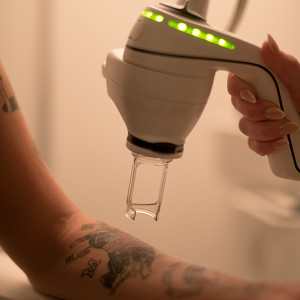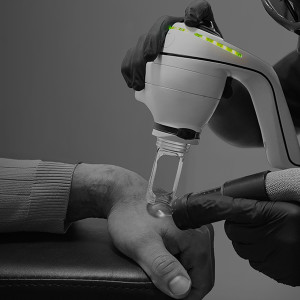JANUARY 26, 2023
Does saline get rid of tattoos?
In this post, we'll take a closer look at what saline removal is, how it works, and whether it's the best option for removing your tattoo.
Tattoos are a form of self-expression that many of us choose to adorn our bodies with. But as time goes by, our tastes, preferences, and circumstances change, and we may find ourselves wanting to get rid of our tattoos. If you're in this boat, you may have heard of saline tattoo removal as an alternative to laser tattoo removal. Saline tattoo removal, also known as saline solution tattoo removal or saline tattoo wash, is a method that is sometimes used to try to remove tattoos. But here's the thing: it's not very effective and can cause serious side effects.
Publish Date in article
What is saline tattoo removal?
Saline tattoo removal is a non-laser method of fading away tattoos. Instead of using intense beams of light to break down the ink particles, saline tattoo removal uses a saline removal solution that's injected into the tattooed area. The solution is made up of salt water and a mild acid, which helps to break down the ink particles and gradually fade the tattoo.
How does saline tattoo removal work?
The process of saline tattoo removal is relatively simple. Your tattoo artist or practitioner will first clean the area around the tattoo and then make a small puncture in the skin using a needle. They'll then inject the saline solution into the tattooed area. The solution will be left to sit for a few minutes before being removed. The tattoo artist will then repeat this process several times, gradually fading the tattoo over a period of several weeks or months.
Publish Date in article
Saline tattoo removal is more invasive and is can cause scarring or other harmful side effects. Image credit: Killer Beauty
Is saline or laser removal better for getting rid of tattoos?
Saline tattoo removal can be used to fade away traditional and cosmetic tattoos, but it's not as effective as laser treatments for complete removal. The ink particles in tattoos are typically too large to be broken down by the saline solution, so it can take multiple sessions to see any significant fading. Saline tattoo removal can only be used to remove certain types of tattoo pigment, such as those that are black or dark blue in colour. Other colours may not respond as well to the treatment.
Laser tattoo removal is generally considered to be the best option for removing tattoos. Here are a few reasons why:
Lasers are more precise and can target specific colours of ink, making it more effective for removing tattoos of different colours.
Laser removal can break down the ink particles more effectively and quickly, making it a faster and more efficient option.
Laser tattoo removal is less invasive and is less likely to cause scarring or other side effects.
At NAAMA, we use the latest laser technology to remove tattoos, ensuring a safe and effective treatment. So, if you're looking to remove a tattoo, laser tattoo removal is your best bet.
By following the prescribed aftercare instructions, ensuring your body’s immune system is in great shape and maintaining a healthy lifestyle, you can often see results in months versus years. This is because the lymphatic system does a lot of the heavy lifting carrying out the ink particles out of the body through the bloodstream. The stronger it is, the better results you’ll see.
The saline tattoo removal process may not be suitable for all skin types, especially if you have sensitive skin, whereas the LightSense™ technology used by NAAMA is skin-kind.
To sum it up, saline tattoo removal is a viable alternative to laser tattoo removal, but it's not as effective at removing tattoo ink and can only be used to remove certain types of tattoos. Laser tattoo removal, on the other hand, is a more efficient and precise option, making it the best choice for removing tattoos.
Publish Date in article
Removal results after just 2 laser tattoo removal treatments at NAAMA using LightSense™.
Side effects of saline tattoo removal
Infection
Because a needle is used to inject the saline solution into the tattooed area, there is a risk of infection. This risk is higher if the area is not properly cleaned before the procedure or if the needle is not sterile.
Scarring
One of the main problems with the saline removal procedure is that it can cause scarring. The saline solution can damage the skin and cause scar tissue to form. This can be unsightly and can make the tattoo more difficult to remove.
Changes in skin pigmentation
Another potential side effect of saline tattoo removal is changes in skin pigmentation. The saline solution can cause the treated area of skin to become lighter or darker than the surrounding skin. This can be difficult to reverse and may require further medical intervention.
Because tattoo removal is non-invasive, the skin is left in much healthier condition with better removal results.
The final verdict - go for laser tattoo removal
The idea behind saline removal of tattoos and permanent makeup is that you inject a saline solution into the tattooed area and it causes the tattoo ink to fade and be eliminated by the body. But the reality is that it doesn't work very well and can cause scarring and changes in skin pigmentation. Yikes!
Laser tattoo removal, on the other hand, is a much safer and more effective method. It uses laser technology to break down the tattoo ink into tiny particles, which are then eliminated by the body's immune system. This method is non-invasive, has a low risk of side effects, and can effectively remove tattoos of various sizes and colours.
So, if you're considering getting rid of a tattoo, definitely avoid saline tattoo removal and opt for laser tattoo removal instead. At NAAMA, we use the latest laser technology to ensure safe and effective tattoo removal. If you're looking to remove a tattoo, contact us today to schedule a consultation.
For trends in breakthrough laser tattoo removal technology, here are NAAMA's top FAQs.
What is the best laser for tattoo removal?
What is the newest laser technology for tattoo removal?










